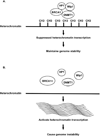Epigenetic changes in BRCA1-mutated familial breast cancer
- PMID: 25800897
- PMCID: PMC4466075
- DOI: 10.1016/j.cancergen.2015.02.001
Epigenetic changes in BRCA1-mutated familial breast cancer
Abstract
Familial breast cancer occurs in about 10% of breast cancer cases. Germline mutation in BRCA1 is the most penetrant predisposition for the disease. Mutated BRCA1 leads to disease by causing genome instability via multiple mechanisms including epigenetic changes. This review summarizes recent progress in studying the correlation between BRCA1 predisposition and epigenetic alterations in BRCA1-type familial breast cancer.
Keywords: BRCA1; autosomal dominant; epigenetic alteration; familial breast cancer; germline mutation.
Copyright © 2015 Elsevier Inc. All rights reserved.
Figures


Similar articles
-
Methylation of Breast Cancer Predisposition Genes in Early-Onset Breast Cancer: Australian Breast Cancer Family Registry.PLoS One. 2016 Nov 30;11(11):e0165436. doi: 10.1371/journal.pone.0165436. eCollection 2016. PLoS One. 2016. PMID: 27902704 Free PMC article.
-
Epigenetic Inactivation of BRCA1 Through Promoter Hypermethylation and Its Clinical Importance in Triple-Negative Breast Cancer.Clin Breast Cancer. 2015 Dec;15(6):498-504. doi: 10.1016/j.clbc.2015.06.009. Epub 2015 Jun 18. Clin Breast Cancer. 2015. PMID: 26195437
-
Genetic and epigenetic characterization of the BRCA1 gene in Brazilian women at-risk for hereditary breast cancer.Oncotarget. 2017 Jan 10;8(2):2850-2862. doi: 10.18632/oncotarget.13750. Oncotarget. 2017. PMID: 27926510 Free PMC article.
-
DNA Methylation and microRNA patterns are in association with the expression of BRCA1 in ovarian cancer.Cell Mol Biol (Noisy-le-grand). 2016 Jan 11;62(1):16-23. Cell Mol Biol (Noisy-le-grand). 2016. PMID: 26828981 Review.
-
BRCA1, hormone, and tissue-specific tumor suppression.Int J Biol Sci. 2009;5(1):20-7. doi: 10.7150/ijbs.5.20. Epub 2008 Dec 13. Int J Biol Sci. 2009. PMID: 19119312 Free PMC article. Review.
Cited by
-
Harnessing Epigenetics for Breast Cancer Therapy: The Role of DNA Methylation, Histone Modifications, and MicroRNA.Int J Mol Sci. 2023 Apr 13;24(8):7235. doi: 10.3390/ijms24087235. Int J Mol Sci. 2023. PMID: 37108398 Free PMC article. Review.
-
The Tumour Microenvironment and Epigenetic Regulation in BRCA1 Pathogenic Variant-Associated Breast Cancers.Cancers (Basel). 2024 Nov 21;16(23):3910. doi: 10.3390/cancers16233910. Cancers (Basel). 2024. PMID: 39682099 Free PMC article. Review.
-
Highly diversified core promoters in the human genome and their effects on gene expression and disease predisposition.BMC Genomics. 2020 Nov 30;21(1):842. doi: 10.1186/s12864-020-07222-5. BMC Genomics. 2020. PMID: 33256598 Free PMC article.
-
Selective Estrogen Receptor Modulators' (SERMs) Influence on TET3 Expression in Breast Cancer Cell Lines with Distinct Biological Subtypes.Int J Mol Sci. 2024 Aug 6;25(16):8561. doi: 10.3390/ijms25168561. Int J Mol Sci. 2024. PMID: 39201247 Free PMC article.
-
Regulation of DNA Damage Response and Homologous Recombination Repair by microRNA in Human Cells Exposed to Ionizing Radiation.Cancers (Basel). 2020 Jul 8;12(7):1838. doi: 10.3390/cancers12071838. Cancers (Basel). 2020. PMID: 32650508 Free PMC article. Review.
References
-
- Siegel R, Naishadham D, Jemal A. Cancer statistics, 2013. CA Cancer. J Clin. 2013;63(1):11–30. - PubMed
-
- U.S. Preventive Services Task Force. Genetic risk assessment and BRCA mutation testing for breast and ovarian cancer susceptibility: recommendation statement. Ann Intern Med. 2005;143(5):355–361. - PubMed
-
- Hall JM, Lee MK, Newman B, et al. Linkage of early-onset familial breast cancer to chromosome 17q21. Science. 1990;250(4988):1684–1689. - PubMed
-
- Miki Y, Swensen J, Shattuck-Eidens D, et al. A strong candidate for the breast and ovarian cancer susceptibility gene BRCA1. Science. 1994;266:66–71. - PubMed
Publication types
MeSH terms
Substances
Supplementary concepts
Grants and funding
LinkOut - more resources
Full Text Sources
Other Literature Sources
Miscellaneous

